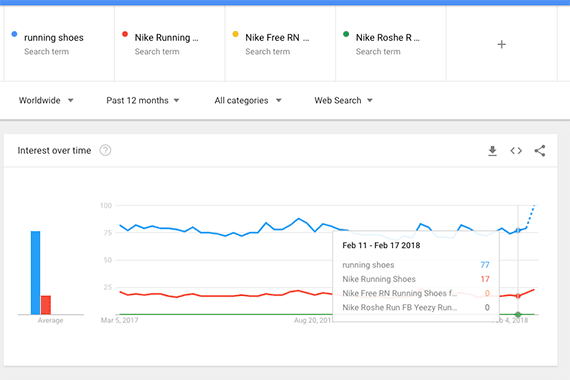A robust content marketing campaign may attract shoppers searching on long-tail keyword phrases, which could generate additional sales.
The term “long tail” describes statistical distributions where there are many points, if you will, far from the peak or central part of a curve.
Many more folks, for example, search for the phrase “Running Shoes” than for “Nike Running Shoes.” Similarly, more people search for “Nike Running Shoes” than for “Nike Free RN Running Shoes for Men.” The more specific a search, the further down the long tail it is.

The more specific a search term, the further down the tail it will be. In this example, “Running Shoe,” a general phrase, produces more search results than “Nike Roshe Run FB Yeezy Running Shoes for Men Size 9,” a long-tail phrase.
—

Google’s data confirms the long tail. A general term gets many more searches each year than does a very specific term. But the very specific term may be far more meaningful and may imply that the searcher is more likely to engage or convert.
Chris Anderson, writing for Wired magazine in 2004, coined the term “long tail” for search engine optimizers, marketers, and ecommerce business owners. Anderson suggested that businesses, such as online retailers, could become very successful online by focusing on the long tail, or, put another way, by offering relatively hard-to-find products.
Since the release of his first long-tail article, there have been many studies and reports that supported Anderson’s supposition. One of the best ways to succeed in a very competitive online market is, in fact, to optimize for long-tail search.
Long-tail Conversions
As far back as 2010, as an example, most of Amazon’s book sales (approximately 57 percent) came from long-tail search queries.
By offering hard-to-find books, Amazon drove many sales in spite of the fact that relatively few people might look for a specific title. Individually, these books might not sell many copies, but collectively they amount to quite a lot of sales.
Similarly, Anderson pointed out that, at the time, Walmart would not stock a CD in its stores unless it was likely to sell at least 100,000 copies. That left a lot of room for other businesses to focus on CDs that might sell 80,000, 50,000, or just 1,000 copies.
This basic approach is also true for content marketing. A depth of specific, useful content will likely attract visitors who have very detailed interests and intent.
In turn, the more focused a site visitor is, the more likely that visitor will convert or engage. Thus, if a business can drive more long-tail site traffic, it may see an increase in sales.
Long-tail SEO
Rand Fishkin, co-founder of Moz and C.E.O. at influencer marketing company SparkToro, suggested that there are two approaches to long-tail search engine optimization.
The first method is to research and optimize for a small set of low-volume but high-converting long-tail keywords. The second is not to focus on traditional SEO for long-tail words, but rather focus on customer-centric content marketing.
The idea is simple. If a company’s marketing organization can generate a volume of unique, useful, informative, or entertaining content, that company will begin to attract a significant amount of long-tail search traffic.
For example, a brick-and-click retail chain headquartered in the Northwestern United States has published about 330 content-rich videos on YouTube. On average, each video gets about 136 views a month.
For some, 136 views a month might not seem like much. But collectively, the company’s videos are watched about 45,000 times every 30 days. In January, viewers spent the equivalent of 94 days — one minute at a time — watching this retailer’s YouTube content.
Content marketing’s basic premise is that when your business provides helpful content, potential customers feel a sense of reciprocity and ultimately purchase. If this is correct, content marketing not only has the potential to attract long-tail search traffic, it should also help your business sell more.
Volume of Content
Long-tail SEO requires a significant amount of content since the business is not focusing on high-traffic keyword phrases and optimized landing pages, but rather on the specificity of content to drive traffic.
In practice, this implies that the company using content marketing to help with long-tail SEO has a few options.
- Develop a body of evergreen content over a relatively long time.
- Develop a lot of content in-house all of the time.
- Rely on users to generate content.
The first case, slowly developing content over a relatively long time, is how the retailer mentioned above created its 330 YouTube videos. The first of the company’s YouTube videos was published in April 2014, nearly four years ago. The business chipped away at video creation, publishing about three videos every two weeks on average.
Mid-market or enterprise ecommerce operations might simply generate a lot of content all of the time. For example, Lowe’s publishes content on YouTube; maintains a significant “Ideas” content section on its website; has a Lowe’s TV app for Apple TV, Amazon Fire, and Roku; and releases content on its social media.
Finally, user-generated content can help. Merchants, for example, may encourage customer forums, user-managed question-and-answer sections, or even product reviews. All of this content can be useful. And all of it can drive long-tail search traffic.